
Macquarie Street is a street in the central business district of Sydney in New South Wales, Australia. Macquarie Street extends from Hyde Park at its southern end to the Sydney Opera House at its northern end. Apart from connecting these two major landmarks, the key government institutions of the state of New South Wales are all located on this street.

Australia Square Tower is an office and retail skyscraper in the Sydney central business district, Australia. Its main address is 264 George Street, and the square is bounded on the northern side by Bond Street, eastern side by Pitt Street and southern side by Curtin Place.

Chifley Tower is a skyscraper in Sydney, Australia. It was designed by New York City-based architects Travis McEwen and Kohn Pedersen Fox, with John Rayner as project architect. At a height of 244 metres, Chifley Tower was the tallest building in Sydney from 1992 to 2019. It was surpassed in height by Crown Sydney in 2020 along with the Salesforce Tower and One Sydney Harbour in 2022.
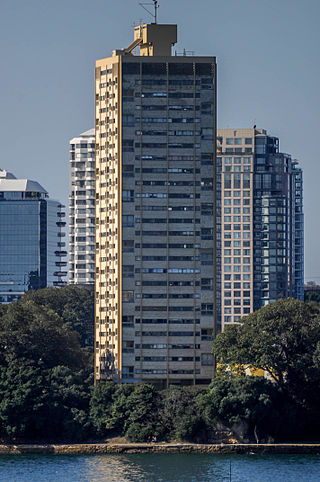
Blues Point Tower is an apartment block in Sydney, Australia. Located in McMahons Point, close to North Sydney, the tower is 83 metres (272 ft) tall with 144 apartments over 24 levels. The building is regarded by some critics as one of the ugliest buildings in Sydney.
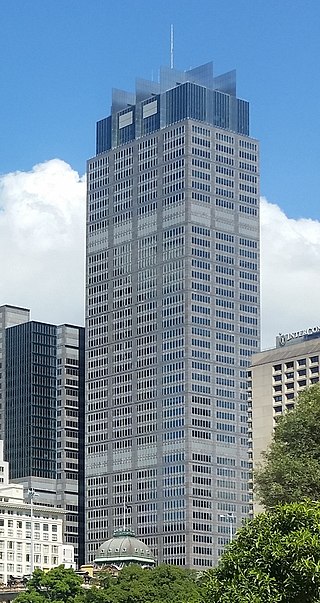
Governor Phillip Tower, Governor Macquarie Tower and the Museum of Sydney are the main elements of a large development in the Sydney central business district in the state of New South Wales, Australia. Completed in 1994, the property development complex occupies an elevated site in the north-east area of the central business district. The complex incorporates the site of the first Government House, one of Australia's earliest and most significant sites of European heritage. The address is 1 Farrer Place. Designed by architects Denton Corker Marshall and built by Grocon, at the time of its completion it was regarded as achieving new standards for Sydney commercial architecture in terms of finish quality and design.
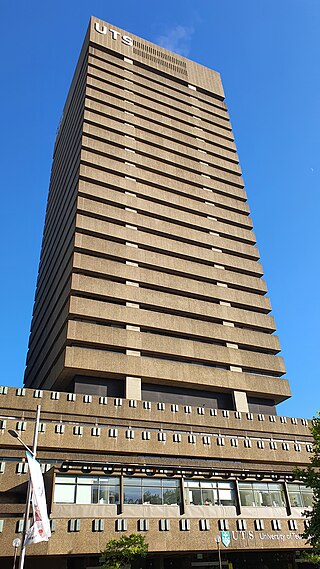
UTS Building 1, also known as the UTS Tower, is a landmark building on Broadway at the southern gateway to Sydney's central business district. Many of the administrative units of the University of Technology, Sydney are located across the building's 27 occupied floors. Completed in 1979 in the brutalist architectural style from a 1968 plan by Michael Dysart of the NSW Government Architect's Office, the Tower was officially opened by NSW Premier Neville Wran.
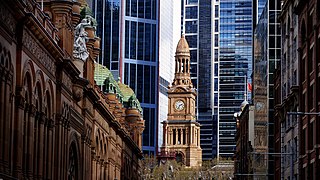
The architecture of Sydney, Australia’s oldest city, is not characterised by any one architectural style, but by an extensive juxtaposition of old and new architecture over the city's 200-year history, from its modest beginnings with local materials and lack of international funding to its present-day modernity with an expansive skyline of high rises and skyscrapers, dotted at street level with remnants of a Victorian era of prosperity.

Parliament House,Sydney is a group of heritage-listed buildings which houses the Parliament of the state of New South Wales. The main building is located on the east side of Macquarie Street in Sydney, the capital of New South Wales. The façade consists of a two-storey Georgian building, the oldest public building in the City of Sydney, flanked by two neo-gothic additions containing the parliamentary chambers. These buildings are linked to a 1970s twelve-storey office block at the rear, facing onto the Domain. It is also variously known as the Parliament of New South Wales, Parliamentary Precinct and the Rum Hospital.

Sydney sandstone, also known as the Hawkesbury sandstone, yellowblock, and yellow gold, is a sedimentary rock named after Sydney, and the Hawkesbury River north of Sydney, where this sandstone is particularly common.

The General Post Office is a heritage-listed landmark building located in Martin Place, Sydney, New South Wales, Australia. The original building was constructed in two stages beginning in 1866 and was designed under the guidance of Colonial Architect James Barnet. Composed primarily of local Sydney sandstone, mined in Pyrmont, the primary load-bearing northern façade has been described as "the finest example of the Victorian Italian Renaissance Style in NSW" and stretches 114 metres (374 ft) along Martin Place, making it one of the largest sandstone buildings in Sydney.
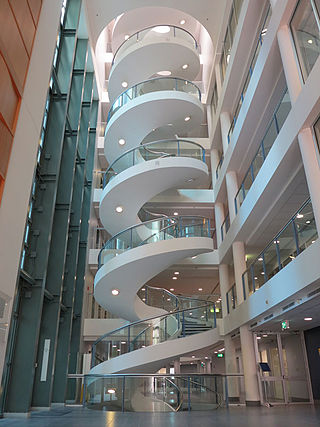
Kenneth Frank Charles Woolley, BArch, Hon DSc Arch Sydney LFRAIA, FTSE, was an Australian architect. In a career spanning 60 years, he is best known for his contributions to project housing with Pettit and Sevitt, four time Wilkinson Award-winning architect, including three times for his own house, the first being the 1962 Woolley House in Mosman, and his longstanding partnership with Sydney Ancher and Bryce Mortlock. He is regarded as being a prominent figure in the development of the Sydney School movement and Australian vernacular building.

The Department of Lands building is a heritage-listed state government administrative building of the Victorian Renaissance Revival architectural style located in Bridge Street in the Sydney central business district of New South Wales, Australia. The large three-storey public building was designed by Colonial Architect James Barnet and built in different stages, with Walter Liberty Vernon and William Edmund Kemp designing various components of the building. The builder was John Young.

Woolley House is a heritage-listed residence located at 34 Bullecourt Avenue, Mosman, in the Mosman Council local government area of New South Wales, Australia. It was designed by Ken Woolley and built during 1962 by Pettit, Sevitt and Partners. It was added to the New South Wales State Heritage Register on 25 May 2001. The Woolley House is considered a classic example of the Sydney School style of architecture and was the recipient of the Australian Institute of Architects NSW Chapter Wilkinson Award in the year of its construction, the highest award for housing in New South Wales. In 2016 the house was bequeathed to the University of NSW. In 2022 the house was awarded the National Award for Enduring Architecture by the AIA.

6 & 8 Parramatta Square is a skyscraper in Parramatta, New South Wales, Australia, a centrepiece of the Parramatta Square development. The building consists entirely of commercial office space, making up 120,000 square metres (1,300,000 sq ft) of floorspace, at a height of 225.45 metres (739.7 ft), making it the tallest building in Parramatta and outside the Sydney central business district. It was built in the Parramatta Square Development on plot 8 called PSQ8.
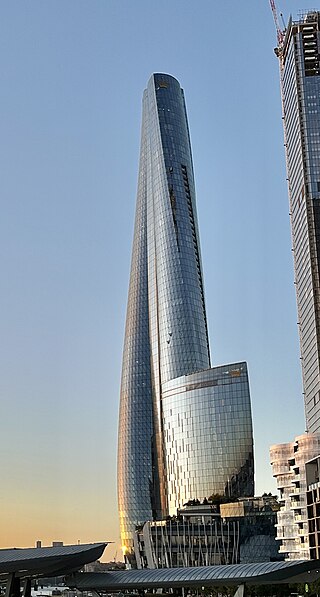
Crown Sydney is a skyscraper in Barangaroo, New South Wales, Australia. Designed by WilkinsonEyre, it stands at a height of 271.3 m (890 ft) with 75 floors, making it the tallest building in Sydney and 4th tallest in Australia. It was developed by Crown Resorts, primarily comprising a hotel and residential apartments, while a casino and other hospitality venues make up the rest of its floorspace. Construction began in October 2016, and the building was topped out in March 2020. It was inaugurated to the public in December 2020.

The Treasury Building, or the Colonial Treasury Building, The Old Treasury Building, or the Treasury Building & Premier's Office, is a heritage-listed former government administration building and now hotel located at the junction of Macquarie and Bridge streets in the central business district of Sydney in New South Wales, Australia. Commenced in 1849 and completed in stages in 1851, 1853, 1900 and 1919 in the Victorian Neo-Classical and Italian Palazzo styles by NSW Colonial and Government architects Mortimer Lewis, Edmund Blacket, Walter Liberty Vernon, and George McRae, the building has been used variously by the NSW Treasury, the Audit Office, the Premier's Department, the Police Department, and the Ministry of Transport. In 1981 the building was sold to the InterContinental Hotel group, with a major hotel complex built on part of the site and much of the heritage building restored.

The MLC Building is a landmark modernist skyscraper in the central business district of North Sydney, on a block bounded by Miller Street, Denison Street and Mount Street. Planned in 1954 and completed in 1957, the complex was designed in the modernist Post-war International style by architects, Bates, Smart & McCutcheon. Its completion marked the appearance of the first high-rise office block in North Sydney and the first use of curtain wall design. Built to provide much-needed office space for the Mutual Life & Citizens Assurance Company Limited, the building continues to be primarily-occupied by its original tenants. It was added to the New South Wales State Heritage Register on 2 January 2024.

The Law Courts Building is a building on Queens Square in Sydney, Australia, completed in 1977 in Twentieth Century Brutalist style. It is the seat of the Supreme Court of New South Wales, as well as parts of the Federal Court of Australia and the High Court of Australia.

The Rural Bank Building was a landmark bank and commercial building on a block bounded by Martin Place, Elizabeth Street and Phillip Street in the Sydney central business district, Australia. Completed in 1936 and designed in the Inter-war Art Deco style by the bank's chief architect, Frank William Turner, the building served as the Rural Bank's main headquarters until 1982. Despite its distinctive design receiving recognition for its heritage value as "one of the finest art deco buildings in Australia", including from the Australian Institute of Architects and through a listing on the Federal Register of the National Estate, the Rural Bank Building was controversially demolished in 1983 and replaced by the postmodern State Bank Centre development by Peddle Thorp & Walker, prompting greater community efforts to protect the heritage of Sydney.


















